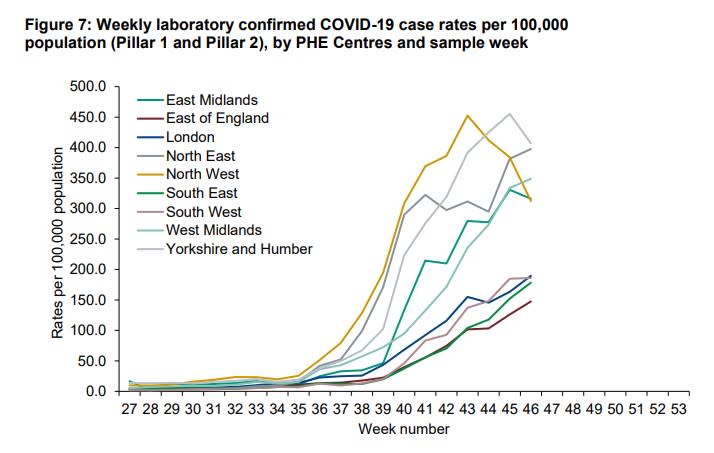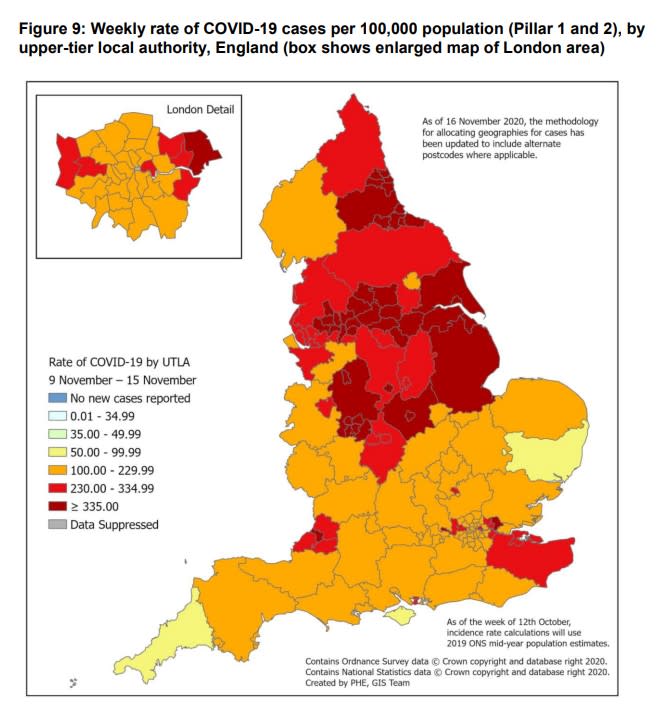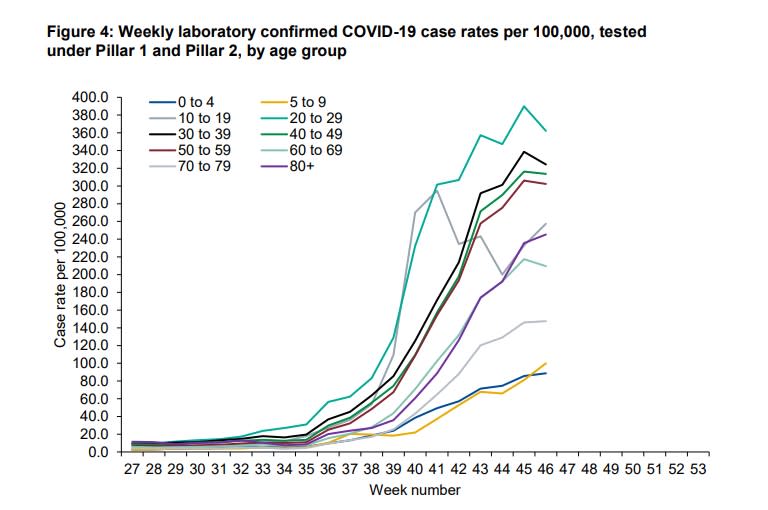The 5 areas of England where lockdown is having the least impact
England’s second lockdown has yet to have much effect in 5 regions of the country, the latest data shows.
The nation went back into lockdown at the start of November and is due to leave it on December 2.
At the time Prime Minister Boris Johnson said the measures were necessary to stop the NHS from being overwhelmed after the number of cases in England began to soar.
A report by Public Health England (PHE) that looks at the latest testing data up until November 15, it shows that while some areas of England have seen a decline in the number of positive tests, in other areas not much has changed.
The report found the in the first and second week of the November lockdown, week 45 and 46, positive tests continued to rise in the South West, the South East, London, the West Midlands and North East.

Most of those areas did see a slight decline in the trajectory of positive tests but they were still climbing.
In some of the most hard-hit areas cases had already begun declining, indicating the Tier 3 measures had had an effect.
The North West and Yorkshire and Humber both started to see a decline in cases before the national lockdown was introduced.
Many people who tested positive in week 45 will have caught the virus in the week before lockdown began and it will only be in the final two weeks of the measures when we will get a clearer picture of if it has worked or not.

Read more: Coronavirus restrictions 'will be place until next summer, regardless of vaccine'
PHE also noted the number of positive tests remains high across the country with most of England seeing more than 100 new cases per 100,000 of the popultion per week, with large parts of the North seeing more than 335.
As of yesterday, Hull had the most cases per 100,000 in the country with 751.
Swale in Kent has the second-highest rate with 618 and Hartlepool is in third place with 590.
There were 22,915 new cases of coronavirus on Thursday, lower from the record 33,470 cases seen last week.
The seven day rolling average of cases in the UK has begun to dip after hitting a high earlier in November.

There were 501 new deaths on Thursday, up from 412 last week.
Deaths have been rising recently and are expected to continue to climb due to the lag between catching the virus and needing hospital attention.
PHE did find that cases were falling among almost all age groups which indicated lockdown was working.
The 20-29 age bracket still accounted for the most numbers of positive cases but had seen a sharp drop since lockdown was introduced.
Worryingly, positive cases continued to climb for all people over 70.
The youngest in society still continue to see their cases numbers climb but as most of them will be at school they are the age group that has been least affected by the latest lockdown.
Watch: COVID-19: Christmas rules to be made public 'next week', says Downing Street
The figures show a mixed picture and will make it harder for the government to make a final decision about what to do over Christmas.
It is expected Downing Street will announce some form of rules relaxation over the Christmas period to allow for some households to mingle.
Yesterday, Dr Susan Hopkins told the Downing Street briefing that Sage scientific advice indicated that “for every day that we release (measures) we will need two days of tighter restrictions”.
“So, coming into Christmas we need to be very careful about the number of contacts that we have, to reduce transmission before Christmas and get our cases as low as possible.
“Hopefully the Government will make the decision that will allow us to have some mixing, but we will wait and see what that is.
“Then, I think, once we have got past the Christmas period if there has been a release and some socialisation we will all have to be very responsible and reduce those contacts again.”
Read more: Did Sweden’s no-lockdown COVID strategy work?
Deputy chief scientific adviser Dame Angela McLean indicated the Sage advisory panel had been examining potential relaxation of measures over Christmas.
She told a Downing Street briefing: “We did send some advice in over the weekend.
“But we genuinely don’t know what decisions have been made.”
Asked whether households mixing could be allowed if there were other trade-offs, Dame Angela said: “What’s really important is we go into a festive week when we want to mix with our friends and our family with the number of infections in the community as low as possible.”
Coronavirus: what happened today
Click here to sign up to the latest news and information with our daily Catch-up newsletter

 Yahoo Finance
Yahoo Finance 